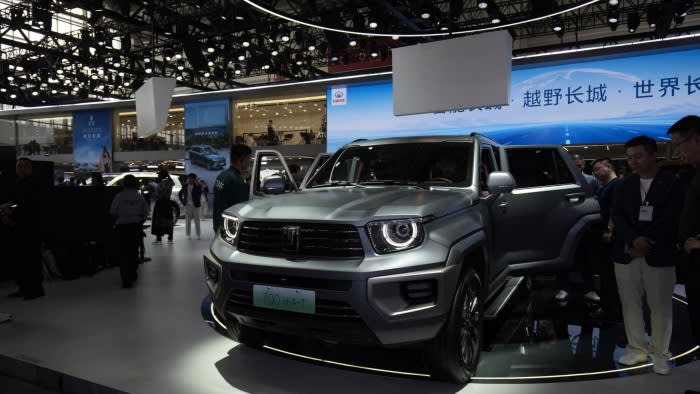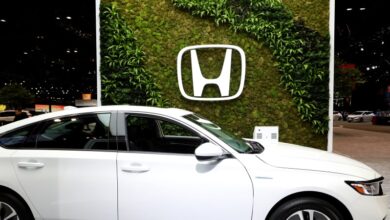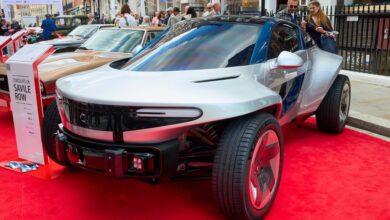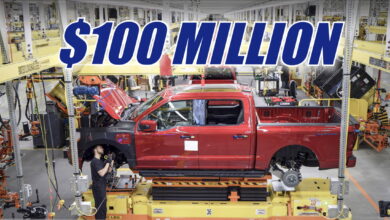Chinese car executive calls west’s claim of overcapacity a ‘fake concept’

Stay informed with free updates
Simply sign up to the Chinese trade myFT Digest — delivered directly to your inbox.
A senior executive at one of China’s biggest privately owned carmakers has said overcapacity in the Chinese car industry is a “fake concept”, joining a chorus of officials and state media hitting back at western criticism of Beijing’s industrial policy.
The Biden administration on Tuesday is expected to announce plans to raise tariffs on Chinese electric vehicle imports from 25 per cent to 100 per cent, along with other new tariffs on clean energy imports.
The announcement comes six months out from the US presidential elections in November and with Biden under pressure over protecting US jobs and managing the world’s biggest economy.
Parker Shi, who leads international operations for Great Wall Motor, acknowledged geopolitical challenges as the company tries to sell more cars overseas. However, criticism of Chinese overcapacity was “not accepted”, he told the Financial Times.
China is expected to make 27mn passenger vehicles this year, despite annual production capacity for 48.8mn units, according to Goldman Sachs forecasts. This is mostly driven by a years-long structural shift in Chinese car sales, with a boom in electric vehicles and a massive fall in sales of internal combustion engine (ICE) cars. Exports are expected to rise 25 per cent this year to more than 5.3mn cars.
“It is a fake concept,” Shi said on the allegations of overcapacity. “I don’t like that kind of judgment from the third party — they don’t know what is happening in my house.”
According to Goldman Sachs, the capacity utilisation rate for plants producing ICE cars in China will decline from 54 per cent of a factory’s capacity being used this year to 48 per cent in 2030. For EVs, capacity utilisation will improve from 58 per cent this year to about 80 per cent by the end of the decade.
Yet senior US and European officials have complained that China, after drawing foreign investment for joint car ventures and obtaining key technologies, has begun offering massive subsidies and cheap loans for domestic producers before dumping excess supply on foreign markets.
Shi, who previously led Great Wall’s operations in India, argued that car companies often designed factories with production capacity beyond their immediate requirements in case of “good business”.
“Some factories [have] 70 to 80 per cent utilisation, some factories 60 per cent, some factories 100 per cent,” he said, adding that in “a lot of countries, official statistics are all wrong”. Great Wall plans to increase manufacturing of its cars overseas, closer to their foreign markets, he added.
Since last year, the European Union has launched probes into EVs imported from China. There have also been two investigations into Chinese solar panel manufacturers that Brussels alleges benefited from market-distorting subsidies and an inquiry into Chinese wind turbine company subsidies.
Chinese President Xi Jinping told French President Emmanuel Macron and European Commission president Ursula von der Leyen in Paris last week that there was no such thing as an overcapacity problem in China, according to statements carried by Chinese state media.
Xi also told Macron and von der Leyen that China’s new energy industry — which includes electric vehicle, solar and wind technology — would not only increase the world’s supply and alleviate the pressure of global inflation but also contribute to the green transition, state media added.
Lin Jian, China’s foreign ministry spokesperson, earlier told reporters in Beijing that accusations of overcapacity ignored “more than 200 years” of basic economic advantage enjoyed by the west.
“If a country should be accused of overcapacity and asked to cut capacity whenever it produces more than its domestic demand, then what would countries trade with?” he said.
“If exporting 12 per cent of Chinese-made EVs is called overcapacity, then what about Germany, Japan and the US, who export 80, 50 and 25 per cent, respectively, of their automobiles?”



